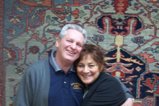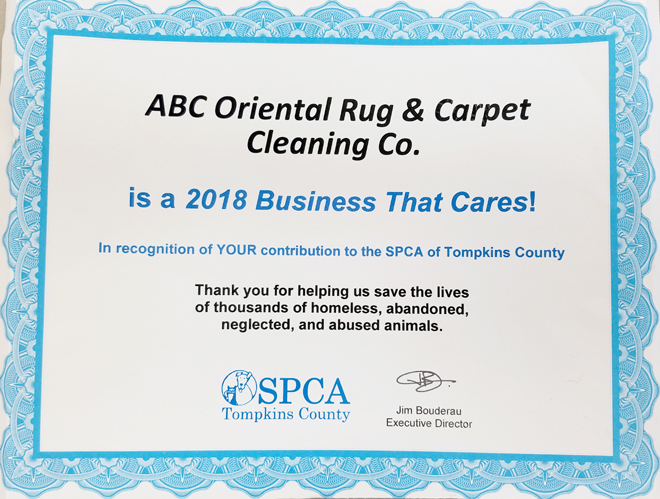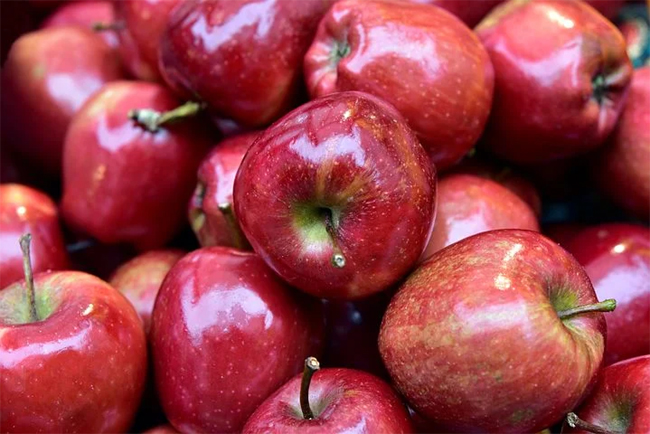ABC MONTHLY NEWSLETTER
November 2020
Welcome to Our Monthly Newsletter!
We hope you will enjoy this month's articles.
This month's topics are:
COVID-19 PANDEMIC
AREA RUGS
MISCELLANEOUS
Native American Heritage Month
CONSIGNMENT RUGS FOR SALE REMINDER
If there is a topic you would like us to cover in one of our upcoming newsletters, please call us at
607-272-1566
or contact us by clicking here.
GREAT NEWS!
GOT QUESTIONS?
NOW YOU CAN TEXT US at
607-272-1566
REMINDER:
Don't forget to keep checking our website for our beautiful
We have more than 25 new rugs hanging as of October!
COVID-19 SURFACE SURVIVAL
A
new research study about COVID-19 surface survival from the Australian
Centre for Disease Preparedness has suggested that the virus can survive
on surfaces for up to 28 days!
But, what about research from the New England Journal of Medicine from the early days of the pandemic which suggested that the SARS-CoV-2 virus could survive on hard surfaces for up to three days but for much shorter times on certain other surfaces such as copper and cardboard? For anyone worrying about survival of the virus outside the body, the standard was set for three days.
As
suggested by this study, if viruses can stay much longer on surfaces
than previously thought, does this imply that even the most meticulous
person could possibly come into contact with some of that virus during
normal activities?
AN IMPORTANT DETAIL WAS LEFT OUT
An important detail that was left out in this COVID-19 surface survival report was that the research was done under ideal lab conditions and these, as we know, can differ greatly from everyday life.
In labs, the researchers will spray a virus-containing solution onto a surface and repeatedly measure for traces of the virus on the surface until no more virus can be detected. It is likely that in these types of controlled situations, viruses would survive for much longer than they would in the real world.
The researchers also knew that factors such as heat and UV light could speed up viral degradation so they also tried to control for these factors in their experiment, even to the point of keeping the samples on different surfaces in incubators to keep them at a constant temperature. Also not reported was that the experime
FOMITE TRANSMISSION OF VIRUSES
Fomites are inanimate objects or materials which are likely to carry infection, such as clothes, utensils, furniture, and hard surfaces in the home or business environment.
An example of a fomite transmission would be if someone has COVID-19 and coughs into their hands and then touches a doorknob. If someone comes by and touches the same doorknob and then touches their face, they introduce the virus into their nasal cavity and that is one way a person can be infected by fomite transmission.
How much COVID-19 is spread in this way is somewhat unclear, but it obviously must happen as evidenced by the fact that handwashing is known to be one of the most effective ways of stopping the spread of any disease.
HOW THE VIRUS SPREADS IS WHAT MATTERS
There is a general scientific consensus that most respiratory viruses are spread from person to person by way of the respiratory droplets that are expelled from our nose and mouth every time we talk, laugh, breathe, cough, etc. However, it is true that there is still an ongoing debate about how far these respiratory droplets can travel and how long they can linger in the air.
Transmission by these droplets no matter how far they can travel and long they can linger makes it very important for us to maintain social distancing and wear a mask. This should be the case until more research can be done and/or a reliable vaccine can be developed and distributed.
WHAT IS IMPORTANT TO REMEMBER ABOUT COVID-19 and SURFACE SURVIVAL?
Please continue reading here for further information on this important subject.
AFSHAR ORIENTAL RUGS
LOCATION
Afshar Oriental rugs are woven by nomadic and semi-nomadic tribes in south central Iran. They produce rugs, tapestries, and saddle bags.
The Afshar nomads and those settled in villages in and around the cities of Shiraz, Kerman, and Yazd continue to speak the well-preserved Turkish dialect of their ancestors.
HISTORY
Afshar nomads were a very prevalent Persian tribal group for centuries and could be found in many regions within the borders of Persia. These groups were a part of the Ohguz Turkmen Confederation consisting of 24 other tribes who came to Persia and Turkey by way of Iran.
Weaving has always been a major artistic outlet as well as a commercial base for these people and it is an art still passed on from one generation to the next.
The antique Afshar oriental rugs are very similar to the antique Caucasian Shirvan rugs and can be collectable.
CONSTRUCTION OF AFSHAR ORIENTAL RUGS
FOUNDATION The
warps (up and down cords) and wefts (side to side cords) which make up
the foundation can be cotton or wool with a depressed warp. (Depressed
warps occur when the wefts are pulled tightly from either side rather
than put in with minimal tension. This will displace the warps into 2
levels).
Afshar
rugs from the Kerman area especially, as well as most of the new Afshar
rugs, are usually constructed on a cotton foundation. They can be more
stiff than those on a wool foundation.
KNOT The knot is the Turkish or symmetrical knot, but occasionally the Persian or asymmetrical knot can be found as used by weavers of Afshar rugs from the Kerman area.
PILE The pile is wool which varies from coarse to medium with a short pile.
ENDS
The
older Afshar rugs have a wide kilim (flat woven area) on the ends,
often with additional decorative stitching. Newer rugs usually have
plain fringe at both ends.
SIDES The sides of Afshar rugs typically exhibit a single cord barber pole or a single color overcasting or multiple bands of color. Occasionally double-corded sides can be found.
COLORS Common colors are bold hues such as deep reds and rich violets, dark blues, saffron gold, ivory, burnt orange, and sienna.
SIZES The Afshar rugs are usually woven in sizes approximately 5x7 or smaller due to their origins as rugs from nomadic tribes with smaller looms. They can also take on a squarish shape. Occasionally, larger sizes can be found.
DESIGN OF
AFSHAR ORIENTAL RUGS
To learn more about Afshar oriental rugs complete with photos, please continue reading here.
BAKHTIARAI ORIENTAL RUGS
BAKHTIARI HISTORY
Bakhtiari oriental rugs woven before 1950 were examples of tribal rugs, which are traditionally smaller rugs with wool yarns hand knotted onto a wool foundation. The nomadic lifestyle of these sheep herding tribes, moving their stock from winter to summer pasture, dictated the necessity of smaller and easily movable looms, using the wool from their sheep for the foundation and pile of their rugs.
Sometime
in the middle of the last century, these nomadic tribes began to settle
in various villages in Western Iran. Weaving looms that did not have to
be seasonally moved could be larger and sturdier, making the production
of larger size rugs possible. The use of cotton for the foundation of
the rugs also became more and more common. Baktiari rugs woven today use
wool pile knotted on cotton foundations.
BAKTIARI ORIENTAL RUGS WEAVING LOCATION TODAY
The Bakhtiari oriental rugs of today are woven in a large number of villages located in an area of Western Iran known as Chahar Mahal.
It
must be noted the weavers of Bakhtiari oriental rugs are typically not
of Bakhtiari tribes, but rather a number of tribes under the rule of
Bakhtiaris.
The rugs coming from this region are all referred to as Bakhtiari rugs. The rugs produced by these formerly nomadic tribes share common designs, structures, and color palettes.
Often, place names are used to refer to the origin of the pattern and the quality of the rug, rather than to the place of actual manufacture. As an example, Saman, Hori, Chahal Shotur and Bibibaff are names used to refer to certain Bakhtiari rugs.
The Bibibaff have a high knot density and are considered one of the best, whereas the Hori are of looser weave and inferior quality. The Chahal Shotur and Saman rugs are considered to be of lower quality than the Bibibaff but are of good quality nonetheless.
Generally speaking, Bakhtiari rugs are made of very good wool with the knots thoroughly beaten down to make the rugs thick and solid. They are considered to be one of the most durable and long-lasting of Persian rugs.
BAKHTIARI DESIGN
Bakhtiari oriental rugs have 2 predominant designs:
1. Garden Panel Design (Khesti)
This
is the most common design with individual squares (sometimes
rectangular, diamond, or hexagonal) decorated with animals and plants.
Each compartment will have a different (and complementary to the others)
color.
The motifs include trees such as the willow and the cypress, grapevines, vases, and birds, etc. Direct influences from the designs of the nearby Persian Isfahan rugs include tree-of-life motifs as well.
To read more about Persian Bakhtiari oriental rugs and their design and construction complete with photos, please continue here.
NOVEMBER is NATIVE AMERICAN HERITAGE MONTH
November
is Native American Heritage Month. Here are some of the famous leaders
whose names still ring through the places, people, and things in
America:
BLACKHAWK
Black Hawk (Ma-ka-tai-me-she-kia-kiak) was born in 1767 in what is now the midwestern part of the US. His village of Sukenuk was on the Rock River which is present-day Rock Island, Illinois. He became a band leader and fierce warrior of the Sauk Native American tribe.
Blackhawk was not a hereditary chief but did inherit an important historic sacred bundle from his medicine man father. He had to earn his status as a war leader and warrior by his actions--leading large numbers of raiding and war parties over many years.
He was very critical of what he considered to be unfair treaties enacted by the US and he sided with the British in the War of 1812 in hopes of pushing white American settlers away from Sauk territory. Later he led a band of Sauk and Fox warriors, known as the British Band, against white settlers in Illinois and present-day Wisconsin during the 1832 Black Hawk War.
Eventually, he was captured by US forces and taken to the Eastern US, where he and other war leaders were taken on a tour of several cities as ordered by President Andrew Jackson. The men were taken by steamboat, carriage, and railroad, and met with large crowds wherever they went. Jackson wanted them to be impressed with the power of the United States.
Shortly
before being released from custody, Black Hawk told his story to an
interpreter. Aided also by a newspaper reporter, he published the Autobiography of Ma-Ka-Tai-Me-She-Kia-Kiak, or Black Hawk, Embracing the Traditions of his Nation in
1833 in Cincinnati, Ohio. The book was one of the first Native American
autobiographies to be published in the US. It became an immediate
bestseller and has gone through several editions.
There is some concern that the final revision of the book may have been edited with potential readers in mind rather than as an accurate record of events relayed by Black Hawk to the interpreter and the newspaper reporter.
Black Hawk died in 1838 in what is now southeastern Iowa.
COCHISE
Cochise, an Apache Chief also known as Shikashe or Adatlichi in Apache, was born in 1805 in the area that is now the northern region of Sonora, Mexico, New Mexico, and Arizona. The Apache people had settled in that region sometime before the arrival of the European explorers and colonists.
Cochise's name meant 'having the quality or strength of an oak.' He became a key war leader during the Apache Wars as principal chief of the Chokonen band of the Chiricahua Apache. He led uprisings against the US government that began in 1861 and persisted until a peace treaty between Cochise and the US government was enacted in 1872.
During the uprisings, the US government found it very difficult to pursue Cochise and capture him. He knew the land well and his people were very effective warriors. However, eventually, the constant running and fighting started to take their toll on the Chiricahua Apache.
The US was also losing too many soldiers and looked for another possible solution to the Cochise problem. Their strategy shifted to relocating him and his people to a reservation. He was repeatedly asked to meet and discuss this but he would always refuse because of the confinement, poor conditions, and poor treatment of natives on reservations.
Finally, in 1872, Cochise was approached by General Howard and Tom Jeffords, an Army scout. The ensuing negotiations gave Cochise a reservation for his people that spanned much of modern day Cochise County in southeast Arizona. This was something Cochise could live with and he did indeed live on the reservation for 2 years until his death in 1874.
The
reservation lasted just 4 years until 1876 when the US moved the
Chiricahua and some other Apache bands to the San Carlos Apache Indian
Reservation. This was in response to public outcry after some white
settlers were killed. Unfortunately, the Indians hated the desert
environment of San Carlos and often left the reservation, sometimes
raiding neighboring settlers. Unrest between the Indians and the
settlers extended the Apache Wars, which continued for many years after
Cochise's death.
CRAZY HORSE
Crazy Horse or Tasunke Witco, was born a member of the Oglala Lakota around 1840 in the Black Hills of South Dakota. His father was a shaman (also named Crazy Horse) and his mother, a member of the Brule Sioux.
As soon as he was old enough, Crazy Horse set out on the Vision Quest or Hanbleceya (crying for a vision or to pray for a spiritual experience), one of the important rites of passage to a Lakota warrior. He went alone into the hills. There he fasted for days and cried to the spirits for a dream.
During that time, he had a vision of an unadorned horseman who directed him to present himself in the same way, with no more than one feather and never a war bonnet. He was also told to toss dust over his horse before entering battle and to place a stone behind his ear and directed to never take anything for himself. He followed the instructions in that dream for his entire life.
By
the time he was in his mid-teens, Crazy Horse was a full-fledged
warrior and exhibited bravery and prowess in battle. In 1876, he led a
band of Lakota warriors against Custer's Seventh US Cavalry battalion.
This was the Battle of the Little Bighorn, also known as Custer's Last
Stand. Custer and all his battalion died and only 32 Indians were
killed. Crazy Horse was also joined by Sitting Bull and his warriors at
the battle.
Crazy
Horse had become an adult during a time when cultures clashed, land
became an issue of deadly contention, and traditional Native ways were
threatened and oppressed. After the Battle of the Little Bighorn, the
United States Government sent scouts to round up any Northern Plains
tribes who resisted. Many Indian Nations were forced to move across the
country, always followed by soldiers, until starvation or exposure would
force them to surrender.
In 1877, under a flag of truce, Crazy Horse surrendered at Fort Robinson in Nebraska and attempted to negotiate with the US Government. Unfortunately, there was a breakdown in negotiations because the translator incorrectly translated what Crazy Horse said and he was escorted toward the jail. When he realized the officers were planning on imprisoning him, he struggled and drew his knife. An infantry guard was able to mortally wound crazy Horse and he died shortly afterward.
It is a well-known fact that Crazy Horse refused to have his picture or likeness taken. Crazy Horse lived under the assumption that by taking a picture a part of his soul would be taken and his life would be shortened. Likenesses of Crazy Horse had to be developed by descriptions from survivors of the Battle of the Little Bighorn and other contemporaries of Crazy Horse the man.
GERONIMO
Geronimo or Goyathlay was born in 1829 in No-Doyohn Canyon, Mexico and became a prominent leader and medicine man from the Bedonkohe band of the Apache tribe. He defended his people against the encroachment of the US on their tribal lands for over 25 years.
From 1850 to 1886, he joined with members of 3 other Chiricahua Apache bands to carry out numerous raids. Geronimo's raids and related combat actions were a part of the prolonged period of the Apache-United States conflict, which started with American settlement in Apache lands following the end of the war with Mexico in 1848.
While Geronimo was well known and a superb leader in raiding and warfare, he was not a chief of the Chiricahua. However, at any one time, he would be in command of about 30 to 50 Apaches.
1876 to 1886 was the final period of conflict for Geronimo. During that time, he had surrendered 3 times and accepted life on the Apache reservations in Arizona. But like other Apaches, reservation life was confining to the free-moving Apache people and they resented restriction on their customary way of life.
In 1886, following Geronimo's third reservation breakout, he surrendered for the last time and the US government treated him as a prisoner of war.
While holding him as a prisoner, the US displayed him at various events capitalizing on his fame among non-Indians.
These displays provided him with an opportunity to make some money. He sold pictures of himself, bows, arrows, buttons off his shirt, and even his hat. In 1898, Geronimo was exhibited at the Trans-Mississippi and International exhibition in Omaha, Nebraska. These exhibitions were so successful, he became a frequent visitor to fairs, exhibitions. and other public functions.
In 1905, the Indian Office provided Geronimo for the inaugural parade for President Theodore Roosevelt. Later that year, the Indian Office took him to Texas, where he shot a buffalo in a staged roundup. He was escorted to the event by soldiers since he was still a prisoner. Apparently, those who witnessed the buffalo hunt were unaware that Geronimo's people were not buffalo hunters!
Geronimo died in 1909, as a prisoner of war.
PONTIAC
For information on other famous Native Americans including Pontiac, please continue reading here.
NOVEMBER SPECIAL
Do More & Save More
All Month!

Please call or text our office at
607-272-1566
for details!
FALL CLEANING SPECIAL
Collect Gift Certificates for the coming Holidays!

Please call or text our office at
607-272-1566
for details!
THANK YOU!! WE LOOK FORWARD TO CONTINUING TO SERVE YOUR TEXTILE CLEANING AND REPAIR NEEDS!
Get New Posts Right To Your Inbox!
Get our monthly newsletter, just like this one, delivered right to your inbox each day. Just sign up and we will send you the best new articles and videos as they become available.
Your email address will NEVER be spammed, sold, or shared. You are welcome to unsubscribe at any time with the link in the email.
Top of October 2020 Newsletter
"The Cleanest Clean You've Ever Seen."
by
ABC Oriental Rug & Carpet Cleaning Co.
130 Cecil Malone Drive Ithaca, NY 14850
607-272-1566

ABC
Carpet & Rug
Spotting Guide

ABC Oriental Rug & Carpet Cleaning Co. has been family-owned and operated in Ithaca and surrounding areas for more 50 years!
Our company is a reflection of our family name and pride.
Please Like us on Facebook!
for more information and to find out what we are doing at our business and in the community!
Stay Connected!
Links to Our Services
Allergy Cleaning
Area Rug Cleaning
Oriental Rug Cleaning
Rug Hand & Machine Repair
Upholstered Furniture Cleaning
Tile & Grout Cleaning & Sealing
We are proud sponsors of the SPCA of Tompkins CO:

Newsletter Archives Categories
~~~~~
~~~~~
Area Rugs & Wall-to-Wall Carpet
~~~~~
General Cleaning, Do-It-Yourself, & Green Cleaning
~~~~~
Wood Floor Coverings & Alternatives
~~~~~
~~~~~
Ceramic Tile & Grout Cleaning & Sealing
~~~~~
Health & Environmental Concerns
~~~~~
~~~~~


